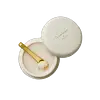What's inside
What's inside
 Key Ingredients
Key Ingredients

 Benefits
Benefits

 Concerns
Concerns

 Ingredients Side-by-side
Ingredients Side-by-side

Polyglyceryl-2 Triisostearate
EmulsifyingCaprylic/Capric Triglyceride
MaskingSqualane
EmollientMica
Cosmetic ColorantButyrospermum Parkii Oil
EmollientHelianthus Annuus Seed Wax
Skin ConditioningPhytosteryl/Octyldodecyl Lauroyl Glutamate
Skin ConditioningDimer Dilinoleyl Dimer Dilinoleate
EmollientSilica
AbrasiveOpuntia Ficus-Indica Seed Oil
EmollientDisteardimonium Hectorite
StabilisingEuphorbia Cerifera Wax
Ceramide NP
Skin ConditioningPalmitoyl Tripeptide-1
Skin ConditioningOpuntia Ficus-Indica Leaf Cell Extract
Skin ProtectingHibiscus Syriacus Callus Extract
AntioxidantRutin
AntioxidantSodium Hyaluronate
HumectantTocopherol
AntioxidantRosa Canina Fruit Oil
EmollientHydrolyzed Collagen
EmollientTribehenin
EmollientHelianthus Annuus Seed Oil
EmollientButylene Glycol
HumectantEthylhexyl Palmitate
EmollientSorbitan Isostearate
EmulsifyingPolyglyceryl-2 Triisostearate, Caprylic/Capric Triglyceride, Squalane, Mica, Butyrospermum Parkii Oil, Helianthus Annuus Seed Wax, Phytosteryl/Octyldodecyl Lauroyl Glutamate, Dimer Dilinoleyl Dimer Dilinoleate, Silica, Opuntia Ficus-Indica Seed Oil, Disteardimonium Hectorite, Euphorbia Cerifera Wax, Ceramide NP, Palmitoyl Tripeptide-1, Opuntia Ficus-Indica Leaf Cell Extract, Hibiscus Syriacus Callus Extract, Rutin, Sodium Hyaluronate, Tocopherol, Rosa Canina Fruit Oil, Hydrolyzed Collagen, Tribehenin, Helianthus Annuus Seed Oil, Butylene Glycol, Ethylhexyl Palmitate, Sorbitan Isostearate
Simmondsia Chinensis Seed Oil
EmollientCaprylic/Capric Triglyceride
MaskingIsononyl Isononanoate
EmollientSynthetic Wax
AbrasiveJojoba Esters
EmollientMicrocrystalline Wax
Emulsion StabilisingSynthetic Beeswax
Emulsion StabilisingC12-15 Alkyl Benzoate
AntimicrobialMeadowfoam Estolide
Skin ConditioningCamellia Oleifera Seed Oil
Skin ConditioningRosa Canina Fruit Oil
EmollientHelianthus Annuus Seed Oil
EmollientHelianthus Annuus Seed Extract
Skin ConditioningCassia Angustifolia Seed Polysaccharide
Skin ConditioningCeramide Ng
Skin ConditioningOryza Sativa Bran Extract
Skin ConditioningSclerocarya Birrea Seed Oil
HumectantPunica Granatum Flower Extract
Skin ConditioningSaccharomyces Ferment
Skin ConditioningRosmarinus Officinalis Leaf Oil
MaskingRosmarinus Officinalis Leaf Extract
AntimicrobialLavandula Angustifolia Oil
MaskingCalophyllum Inophyllum Seed Oil
AntimicrobialRubus Idaeus Seed Oil
EmollientFragaria Vesca Fruit Extract
AstringentCarthamus Tinctorius Seed Oil
MaskingCitrus Limon Peel Oil
MaskingPalmitoyl Hexapeptide-12
Skin ConditioningLauroyl Lysine
Skin ConditioningTribehenin
EmollientTocopherol
AntioxidantTocopheryl Acetate
AntioxidantLimonene
PerfumingLinalool
PerfumingSimmondsia Chinensis Seed Oil, Caprylic/Capric Triglyceride, Isononyl Isononanoate, Synthetic Wax, Jojoba Esters, Microcrystalline Wax, Synthetic Beeswax, C12-15 Alkyl Benzoate, Meadowfoam Estolide, Camellia Oleifera Seed Oil, Rosa Canina Fruit Oil, Helianthus Annuus Seed Oil, Helianthus Annuus Seed Extract, Cassia Angustifolia Seed Polysaccharide, Ceramide Ng, Oryza Sativa Bran Extract, Sclerocarya Birrea Seed Oil, Punica Granatum Flower Extract, Saccharomyces Ferment, Rosmarinus Officinalis Leaf Oil, Rosmarinus Officinalis Leaf Extract, Lavandula Angustifolia Oil, Calophyllum Inophyllum Seed Oil, Rubus Idaeus Seed Oil, Fragaria Vesca Fruit Extract, Carthamus Tinctorius Seed Oil, Citrus Limon Peel Oil, Palmitoyl Hexapeptide-12, Lauroyl Lysine, Tribehenin, Tocopherol, Tocopheryl Acetate, Limonene, Linalool
Ingredients Explained
These ingredients are found in both products.
Ingredients higher up in an ingredient list are typically present in a larger amount.
This ingredient is an emollient, solvent, and texture enhancer. It is considered a skin-softener by helping the skin prevent moisture loss.
It helps thicken a product's formula and makes it easier to spread by dissolving clumping compounds.
Caprylic Triglyceride is made by combining glycerin with coconut oil, forming a clear liquid.
While there is an assumption Caprylic Triglyceride can clog pores due to it being derived from coconut oil, there is no research supporting this.
Learn more about Caprylic/Capric TriglycerideHelianthus Annuus Seed Oil is the oil derived from the seeds of a Sunflower. Sunflower seed oil is non-fragrant. It is an emollient, meaning it helps to soften the skin.
Sunflower seed oil contains many fatty acids. The fatty acids found in sunflower seeds include (from highest amount to least): linoleic acid, myristic acid, palmitic acid, stearic acid, arachidic acid, oleic acid, and linolenic acid.
These fatty acids help the skin create ceramides. Ceramides play a role in repairing the skin barrier.
Helianthus Annuus Seed Oil helps moisturize the skin. This in turn helps the skin look more rejuvenated and smoother.
Sunflowers are rich in vitamin E.
Historians believe Indigenous cultures of North America domesticated sunflowers before corn. Thus they relied on sunflower oil for a variety of uses. One such use is moisturizing skin and hair.
Sunflower seed oil may not be fungal acne safe. We recommend speaking with a professional if you have any concerns.
Learn more about Helianthus Annuus Seed OilRosehip Oil is a non-fragrant plant oil. Rosehips are a fruit from a rose bush and are edible. This oil has skin conditioning and hydrating properties.
Rosehip contains Vitamin C, Vitamin E, fatty acids and linolenic acids. These nourish your skin barrier. Having hydrated skin may help reduce the appearance of fine-lines and wrinkles.
Another great component of Rosehip Oil is Vitamin A, or retinol. Vitamin A encourages your skin to create more collagen.
Rosehip oil may help with reducing pigmentation. The lycopene and beta-carotene have skin-lightening properties. However, more studies are needed to confirm this.
Learn more about Rosa Canina Fruit OilTocopherol (also known as Vitamin E) is a common antioxidant used to help protect the skin from free-radicals and strengthen the skin barrier. It's also fat soluble - this means our skin is great at absorbing it.
Vitamin E also helps keep your natural skin lipids healthy. Your lipid skin barrier naturally consists of lipids, ceramides, and fatty acids. Vitamin E offers extra protection for your skin’s lipid barrier, keeping your skin healthy and nourished.
Another benefit is a bit of UV protection. Vitamin E helps reduce the damage caused by UVB rays. (It should not replace your sunscreen). Combining it with Vitamin C can decrease sunburned cells and hyperpigmentation after UV exposure.
You might have noticed Vitamin E + C often paired together. This is because it is great at stabilizing Vitamin C. Using the two together helps increase the effectiveness of both ingredients.
There are often claims that Vitamin E can reduce/prevent scarring, but these claims haven't been confirmed by scientific research.
Learn more about TocopherolTribehenin comes from glycerin and behenic acid.
It is used as an emollient, or moisturizer. Emollients form a thin barrier on skin to prevent moisture from escaping.
This ingredient may not be Malassezia folliculitis, or fungal-acne safe.
Learn more about Tribehenin